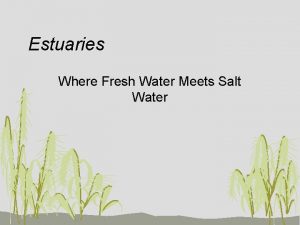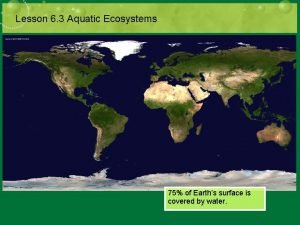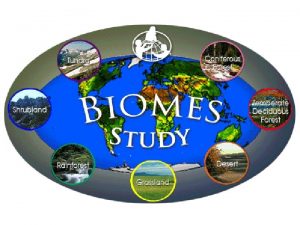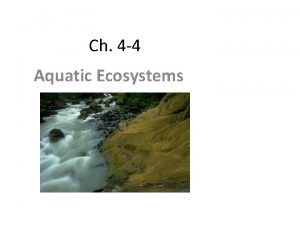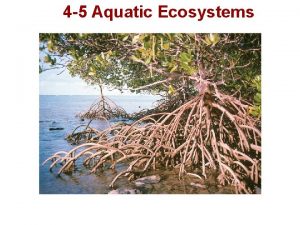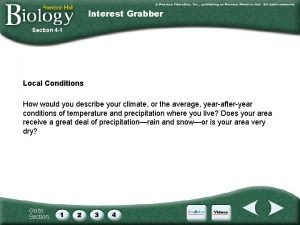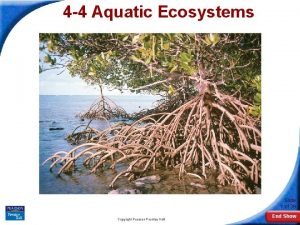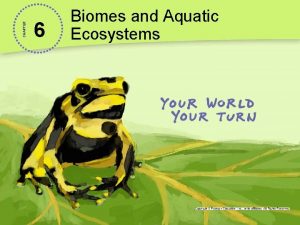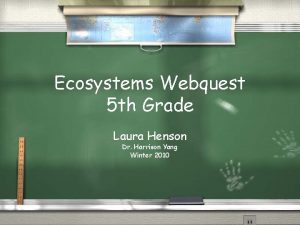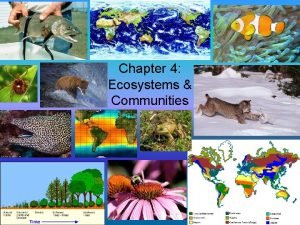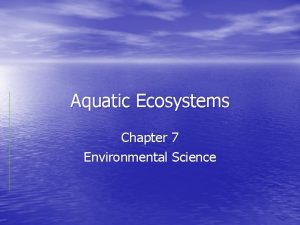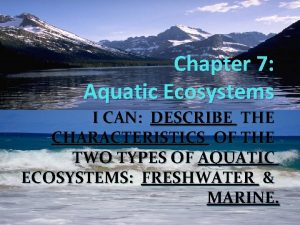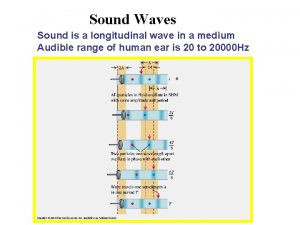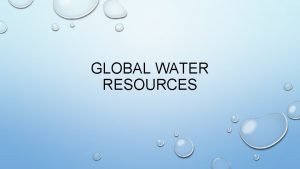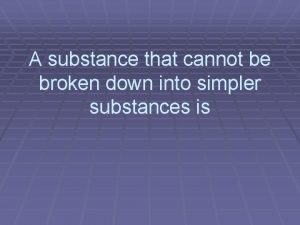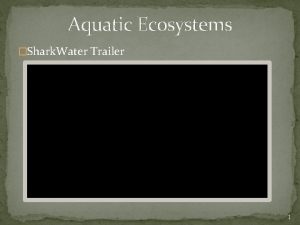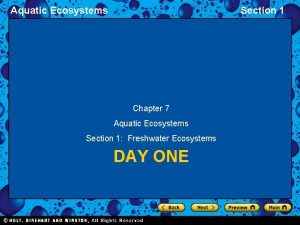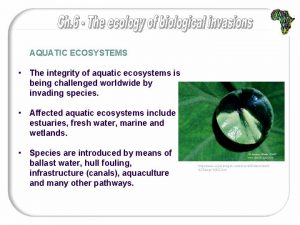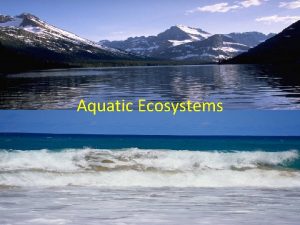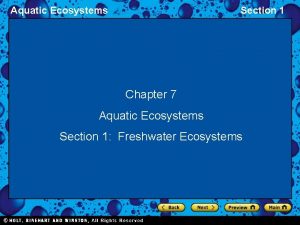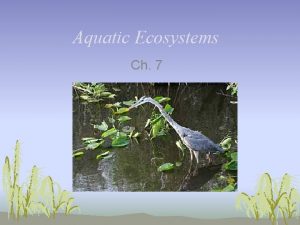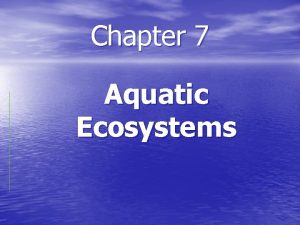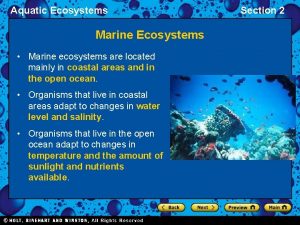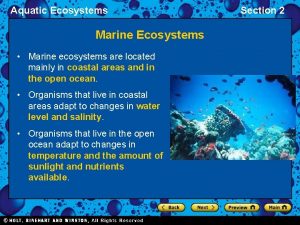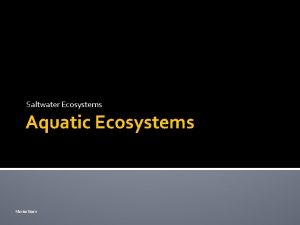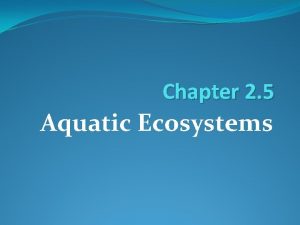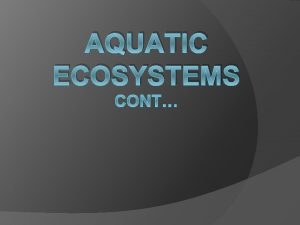Aquatic Ecosystems Salt Water vs Fresh Water Salt

























- Slides: 25

Aquatic Ecosystems

Salt Water vs Fresh Water

Salt Water Ecosystems • Oceans • Coral Reefs • Estuaries • Salt Marshes

Oceans • Large bodies of saltwater divided by continents and has many different types of ecosystems within itself depending on the conditions • • How much sunlight it gets Temperature Depth (how deep it is) Salinity (how salty the water is)

Oceans • Most organisms live where the ocean is shallow • Why do we think this is? ?

Oceans • Most organisms live where the ocean is shallow • Why do we think this is? ? • This is because the sunlight can reach deep and the water is warmer making the food more abundant (lots more food) • Example- seaweed lives close to the surface where there is more sunlight available

Where is this shallow area? • Most organisms live between the coastline and the continental shelf

Oceans • ORGANISMS Examples: • Jellyfish • Seaweed • Fish • Crabs • Corals • Starfish • Stingrays

Open Ocean • Some organisms live in the open ocean • Some near the surface and some near the bottom • Whales, squids, jellyfish, plankton, etc. Plankton float in the upper areas of the water

Oceans • Organisms like whales, turtles, and sharks swim to the surface to find food or for air • Some live close to the bottom (certain fish, octopus, tubeworms, etc. )

Coral Reefs Watch Me!!!

Coral Reefs • Usually where there is lots of wave action because the waves bring in food, nutrients, and oxygen to the reefs • Reefs need calcium which is more available in the shallow warm waters

Estuary Where rivers meet the sea • Body of brackish water with one or more rivers flowing into it • Estuaries form a transition area between river (fresh water) environments and marine (ocean) environments Brackish water- More salinity (salt) than fresh water but not as much as seawater

Salt Marshes Coastal wetlands that are flooded and drained by salt water brought in by the tides of the ocean. • • Soil may be composed of deep mud Salt marshes are found near estuaries “Sea grass” Animals found here: Crabs, grass shrimp, mussels

Fresh Water Ecosystems • Lakes • Ponds

Lakes + Ponds • Fresh bodies of still water surrounded by land

Ponds • More shallow than a lake • Temperature of the water stays the same from the top to the bottom (uniform throughout)

Ponds • Plants and algae usually grow along the edges where the water is shallow

Ponds • Animals: • • Fish Amphibians Ducks Turtles Beavers

review • What kind of water might you find near the coast? • What about near the mountains? • The beach? • Wooded area?

review • Note: Aquariums and Terrarium are both SIMPLE ecosystems • What make a pond different from a lake? • Where do most organisms in an ocean live? • Does the ocean have a uniform temperature from top to bottom? Explain

review • Name one way a pond is different from an estuary • Why do most organisms of the ocean live in the shallow regions • What kind of animals can you find at the deep bottom of the ocean?

review • What would be the main difference in a lake versus a pond? • What is brackish water and where is it found? • Where do organisms such as whales live in the ocean? And why do they live there?

Answer sheet What kind of water might you find near the coast? saltwater What about near the mountains? Fresh water The beach? Saltwater Wooded area? Freshwater What make a pond different from a lake? Ponds are the same temperature from top to bottom • Where do most organisms in an ocean live? Shallow areas: coastline to the continental shelf • Does the ocean have a uniform temperature from top to bottom? Explain no. the further down the colder it gets- this is why most organisms live in the shallow areas- it is warmer (and there is more food for them) • • •

Answer sheet Name one way a pond is different from an estuary? Ponds are freshwater and an estuary is a mix (brackish) of fresh and salt Why do most organisms of the ocean live in the shallow regions It is warmer and there is more food and vegetation there What kind of animals can you find at the deep bottom of the ocean? Octopus What would be the main difference in a lake versus a pond? Lake has differing temperatures from top to bottom and a pond is the same temperature What is brackish water and where is it found? Freshwater and saltwater mix- estuary Where do organisms such as whales live in the ocean? And why do they live there? They live in the open ocean near the top so that they can get oxygen and food
 Fresh water meets salt water
Fresh water meets salt water Lesson 3: aquatic ecosystems
Lesson 3: aquatic ecosystems Biomes and aquatic ecosystems
Biomes and aquatic ecosystems 4-4 aquatic ecosystems
4-4 aquatic ecosystems 4-4 aquatic ecosystems
4-4 aquatic ecosystems Epiphytes plants
Epiphytes plants Section 4-2 what shapes an ecosystem answer key
Section 4-2 what shapes an ecosystem answer key Frog life cycle
Frog life cycle Lesson outline lesson 2 aquatic ecosystems answer key
Lesson outline lesson 2 aquatic ecosystems answer key 4-4 aquatic ecosystems
4-4 aquatic ecosystems 6 biomes and aquatic ecosystems answers
6 biomes and aquatic ecosystems answers Ecosystem webquest 5th grade
Ecosystem webquest 5th grade 4-4 aquatic ecosystems
4-4 aquatic ecosystems Section 3 aquatic ecosystems worksheet answers
Section 3 aquatic ecosystems worksheet answers Chapter 7 aquatic ecosystems test answers
Chapter 7 aquatic ecosystems test answers Chapter 3 lesson 3 biomes and aquatic ecosystems
Chapter 3 lesson 3 biomes and aquatic ecosystems Section 4-4 aquatic ecosystems
Section 4-4 aquatic ecosystems Limestone ridges built by tiny animals
Limestone ridges built by tiny animals Marine ecosystem webquest
Marine ecosystem webquest Dock water allowance adalah
Dock water allowance adalah Water and water and water water
Water and water and water water Water contamination introduction
Water contamination introduction Fresh water density
Fresh water density Speed of sound in fresh water
Speed of sound in fresh water Is salt denser than water
Is salt denser than water You put 1 gram of salt into 1 liter of water and stir
You put 1 gram of salt into 1 liter of water and stir
